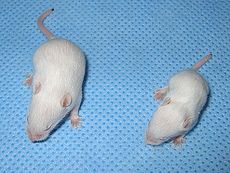- Atrophy
-
For the American thrash metal band, see Atrophy (band)
Atrophy Classification and external resources 
Mice with spinal muscular atrophyMeSH D001284 Atrophy is the partial or complete wasting away of a part of the body. Causes of atrophy include mutations (which can destroy the gene to build up the organ), poor nourishment, poor circulation, loss of hormonal support, loss of nerve supply to the target organ, disuse or lack of exercise or disease intrinsic to the tissue itself. Hormonal and nerve inputs that maintain an organ or body part are referred to as trophic [noun] in medical practice. Trophic describes the trophic condition of tissue. A diminished muscular trophic is designated as atrophy.
Atrophy is the general physiological process of reabsorption and breakdown of tissues, involving apoptosis on a cellular level. When it occurs as a result of disease or loss of trophic support due to other disease, it is termed pathological atrophy, although it can be a part of normal body development and homeostasis as well.
Contents
Atrophy examples
Normal development
Examples of atrophy as part of normal development include shrinking and involution of the thymus in early childhood, and the tonsils in adolescence.
Muscle atrophies
Main article: Muscle atrophyDisuse atrophy of muscles (muscle atrophy) and bones, with loss of mass and strength, can occur after prolonged immobility, such as extended bedrest, or having a body part in a cast (living in darkness for the eye, bedridden for the legs etc.). This type of atrophy can usually be reversed with exercise unless severe. Astronauts in microgravity must exercise regularly to minimize atrophy of their limb muscles.
There are many diseases and conditions which cause atrophy of muscle mass. For example diseases such as cancer and AIDS induce a body wasting syndrome called "cachexia", which is notable for the severe muscle atrophy seen. Other syndromes or conditions which can induce skeletal muscle atrophy are congestive heart failure and liver disease.
During aging, there is a gradual decrease in the ability to maintain skeletal muscle function and mass. This condition is called "sarcopenia", and may be distinct from atrophy in its pathophysiology. While the exact cause of sarcopenia is unknown, it may be induced by a combination of a gradual failure in the "satellite cells" which help to regenerate skeletal muscle fibers, and a decrease in sensitivity to or the availability of critical secreted growth factors which are necessary to maintain muscle mass and satellite cell survival.[1]
Dystrophies, myosities, and motor neuron conditions
Pathologic atrophy of muscles can occur with diseases of the motor nerves, or diseases of the muscle tissue itself. Examples of atrophying nerve diseases include CMT (Charcot Marie Tooth syndrome) poliomyelitis, amyotrophic lateral sclerosis (ALS or Lou Gehrig's disease), and Guillain-Barré syndrome. Examples of atrophying muscle diseases include muscular dystrophy, myotonia congenita, and myotonic dystrophy.
Changes in Na+ channel isoform expression and spontaneous activity in muscle called fibrillation can also result in muscle atrophy.
Gland atrophy
The adrenal glands atrophy during prolonged use of exogenous glucocorticoids like prednisone. Atrophy of the breasts can occur with prolonged estrogen reduction, as with anorexia nervosa or menopause. Atrophy of the testes occurs with prolonged use of enough exogenous sex steroid (either androgen or estrogen) to reduce gonadotropin secretion.
Vaginal atrophy
In post-menopausal women, the walls of the vagina become thinner (Atrophic vaginitis). The mechanism for the age-related condition is not yet clear, though there are theories that the effect is caused by decreases in estrogen levels.[2] This atrophy, and that of the breasts concurrently, is consistent with the homeostatic (normal development) role of atrophy in general, as after menopause the body has no further functional biological need to maintain the reproductive system which it has permanently shut down.
Respiration
In most amphibians and the South-American and African lungfishes, the animals stop breathing through gills and start using lungs instead as they develop towards adult forms.
Research
It has been reported that some drugs might prevent the loss of the muscle wasting that occurs in immobile, bedridden patients.[3] Testing upon mice showed that it blocked the activity of a protein present in the muscle that is involved in muscle atrophy.[4] However the concerns for the drug's long-term effects on the heart preclude its routine use in humans for this indication, and further alternative drugs are being sought.[3] Not exercising is the main cause for muscle atrophy.
See also
- Olivopontocerebellar atrophy
- Optic atrophy
- Spinomuscular atrophy
- Testicular atrophy
- Hypertrophy
References
- ^ Campellone, Joseph V. (2007-05-22). "Muscle atrophy" (html). MedlinePlus. http://www.nlm.nih.gov/medlineplus/ency/article/003188.htm. Retrieved 2007-10-02.
- ^ "Types of Atrophy" (html). http://medicine.science-tips.org/health/diseases-and-conditions/types-of-atrophy.html. Retrieved 2007-10-02.
- ^ a b "Drug could stop muscle wasting'". NetDoctor.co.uk. 2006-05-25. http://www2.netdoctor.co.uk/news/index.asp?y=2006&m=5&d=25&id=123026. Retrieved 2006-05-27.
- ^ Wang X, Hockerman GH, Green Iii HW, Babbs CF, Mohammad SI, Gerrard D, Latour MA, London B, Hannon KM, Pond AL (May24 2006). "Merg1a K+ channel induces skeletal muscle atrophy by activating the ubiquitin proteasome pathway". FASEB J 20 (9): 1531. doi:10.1096/fj.05-5350fje. PMID 16723379.
Medicine: Pathology Principles of pathology Disease/Medical condition (Infection, Neoplasia) · Hemodynamics (Ischemia) · Inflammation · Wound healing
Cell death: Necrosis (Liquefactive necrosis, Coagulative necrosis, Caseous necrosis, Fat necrosis) · Apoptosis · Pyknosis · Karyorrhexis · Karyolysis
Cellular adaptation: Atrophy · Hypertrophy · Hyperplasia · Dysplasia · Metaplasia (Squamous, Glandular)
accumulations: pigment (Hemosiderin, Lipochrome/Lipofuscin, Melanin) · SteatosisAnatomical pathology Surgical pathology · Cytopathology · Autopsy · Molecular pathology · Forensic pathology · Dental pathology
Gross examination · Histopathology · Immunohistochemistry · Electron microscopy · Immunofluorescence · Fluorescent in situ hybridizationClinical pathology Specific conditions Myocardial infarctionClinical and histological nomenclature for skin lesions Macroscopic Primary lesionsSecondary lesionsMicroscopic keratin: Hyperkeratosis · Parakeratosis · Dyskeratosis
Hypergranulosis · Acanthosis · Papillomatosis · Acantholysis · Spongiosis · Hydropic swelling · Exocytosis · Vacuolization · Erosion · Ulceration · LentiginousCategories:
Wikimedia Foundation. 2010.
